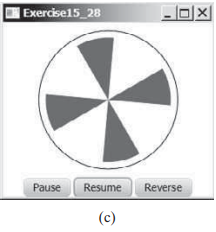(Display a running fan) Write a program that displays a running fan, as shown in Figure 15.33c
belongs to book: Introduction to Java Programming, Comprehensive Version (10th Edition)|Y. Danial liang|10th edition| Chapter number:15| Question number:28
All Answers
total answers (1)





 Java programming
Java programming
FanPane.java
need an explanation for this answer? contact us directly to get an explanation for this answer